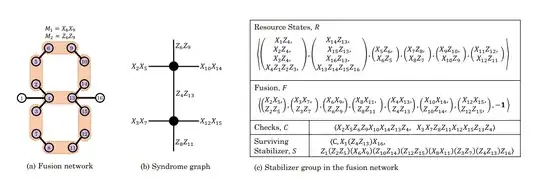Equation 4 of of the paper defines $S=Z_R(F)$.
The generators of $R$ and $F$ are defined by the network and are given in Figure 5c.
The rest is some linear algebra to get $S$.
I was able to verify what's in the paper including the value of $S$ before and after all the measurements (equation 16)...(btw there are probably a few errors in this equation : $m_{a,b}^{XX}$ mixed up with be $m_{a,b}^{ZZ}$...)
Here's GAP code that does the calculation for the example in question :
R:=
[[1,0,0,0,0,0,0,0,0,0,0,0,0,0,0,0,0,0,0,1,0,0,0,0,0,0,0,0,0,0,0,0],
[0,1,0,0,0,0,0,0,0,0,0,0,0,0,0,0,0,0,0,1,0,0,0,0,0,0,0,0,0,0,0,0],
[0,0,1,0,0,0,0,0,0,0,0,0,0,0,0,0,0,0,0,1,0,0,0,0,0,0,0,0,0,0,0,0],
[0,0,0,1,0,0,0,0,0,0,0,0,0,0,0,0,1,1,1,0,0,0,0,0,0,0,0,0,0,0,0,0],
[0,0,0,0,1,0,0,0,0,0,0,0,0,0,0,0,0,0,0,0,0,1,0,0,0,0,0,0,0,0,0,0],
[0,0,0,0,0,1,0,0,0,0,0,0,0,0,0,0,0,0,0,0,1,0,0,0,0,0,0,0,0,0,0,0],
[0,0,0,0,0,0,1,0,0,0,0,0,0,0,0,0,0,0,0,0,0,0,0,1,0,0,0,0,0,0,0,0],
[0,0,0,0,0,0,0,1,0,0,0,0,0,0,0,0,0,0,0,0,0,0,1,0,0,0,0,0,0,0,0,0],
[0,0,0,0,0,0,0,0,1,0,0,0,0,0,0,0,0,0,0,0,0,0,0,0,0,1,0,0,0,0,0,0],
[0,0,0,0,0,0,0,0,0,1,0,0,0,0,0,0,0,0,0,0,0,0,0,0,1,0,0,0,0,0,0,0],
[0,0,0,0,0,0,0,0,0,0,1,0,0,0,0,0,0,0,0,0,0,0,0,0,0,0,0,1,0,0,0,0],
[0,0,0,0,0,0,0,0,0,0,0,1,0,0,0,0,0,0,0,0,0,0,0,0,0,0,1,0,0,0,0,0],
[0,0,0,0,0,0,0,0,0,0,0,0,1,0,0,0,0,0,0,0,0,0,0,0,0,0,0,0,0,1,1,1],
[0,0,0,0,0,0,0,0,0,0,0,0,0,1,0,0,0,0,0,0,0,0,0,0,0,0,0,0,1,0,0,0],
[0,0,0,0,0,0,0,0,0,0,0,0,0,0,1,0,0,0,0,0,0,0,0,0,0,0,0,0,1,0,0,0],
[0,0,0,0,0,0,0,0,0,0,0,0,0,0,0,1,0,0,0,0,0,0,0,0,0,0,0,0,1,0,0,0]];
F:=
[[0,1,0,0,1,0,0,0,0,0,0,0,0,0,0,0,0,0,0,0,0,0,0,0,0,0,0,0,0,0,0,0],
[0,0,0,0,0,0,0,0,0,0,0,0,0,0,0,0,0,1,0,0,1,0,0,0,0,0,0,0,0,0,0,0],
[0,0,1,0,0,0,1,0,0,0,0,0,0,0,0,0,0,0,0,0,0,0,0,0,0,0,0,0,0,0,0,0],
[0,0,0,0,0,0,0,0,0,0,0,0,0,0,0,0,0,0,1,0,0,0,1,0,0,0,0,0,0,0,0,0],
[0,0,0,0,0,1,0,0,1,0,0,0,0,0,0,0,0,0,0,0,0,0,0,0,0,0,0,0,0,0,0,0],
[0,0,0,0,0,0,0,0,0,0,0,0,0,0,0,0,0,0,0,0,0,1,0,0,1,0,0,0,0,0,0,0],
[0,0,0,0,0,0,0,1,0,0,1,0,0,0,0,0,0,0,0,0,0,0,0,0,0,0,0,0,0,0,0,0],
[0,0,0,0,0,0,0,0,0,0,0,0,0,0,0,0,0,0,0,0,0,0,0,1,0,0,1,0,0,0,0,0],
[0,0,0,1,0,0,0,0,0,0,0,0,1,0,0,0,0,0,0,0,0,0,0,0,0,0,0,0,0,0,0,0],
[0,0,0,0,0,0,0,0,0,0,0,0,0,0,0,0,0,0,0,1,0,0,0,0,0,0,0,0,1,0,0,0],
[0,0,0,0,0,0,0,0,0,1,0,0,0,1,0,0,0,0,0,0,0,0,0,0,0,0,0,0,0,0,0,0],
[0,0,0,0,0,0,0,0,0,0,0,0,0,0,0,0,0,0,0,0,0,0,0,0,0,1,0,0,0,1,0,0],
[0,0,0,0,0,0,0,0,0,0,0,1,0,0,1,0,0,0,0,0,0,0,0,0,0,0,0,0,0,0,0,0],
[0,0,0,0,0,0,0,0,0,0,0,0,0,0,0,0,0,0,0,0,0,0,0,0,0,0,0,1,0,0,1,0]];
C is intersection of R and F (equation 12)
C:=Intersection(VectorSpace(GF(2),RZ(2)),VectorSpace(GF(2),FZ(2)));
C:=BasisVectors(Basis(C));
C:=List(C,x->List(x,Int));
symplectic null space of F : all paulis that commute with F
n:=16;
T:=NullspaceMat(TransposedMat(F*Z(2)));
T:=List(T,x->Concatenation(x{n+[1..n]},x{[1..n]}));
limit to those in R (equation 4)
S:=Intersection(VectorSpace(GF(2),RZ(2)),VectorSpace(GF(2),TZ(2)));
S:=BasisVectors(Basis(S));
S:=List(S,x->List(x,Int));
Print("C=\n",C,"\n");
Print("S=\n",S,"\n");
running it (takes seconds) givse C and S; note that C is included in S as expected :
C=
[[0,1,0,0,1,0,0,0,0,1,0,0,0,1,0,0,0,0,0,1,0,1,0,0,1,0,0,0,1,0,0,0],
[0,0,1,0,0,0,1,0,0,0,0,1,0,0,1,0,0,0,0,1,0,0,0,1,0,0,1,0,1,0,0,0]]
S=
[[1,0,0,0,0,0,0,0,0,0,0,0,0,0,0,1,0,0,0,1,0,0,0,0,0,0,0,0,1,0,0,0],
[0,1,0,0,1,0,0,0,0,1,0,0,0,1,0,0,0,0,0,1,0,1,0,0,1,0,0,0,1,0,0,0],
[0,0,1,0,0,0,1,0,0,0,0,1,0,0,1,0,0,0,0,1,0,0,0,1,0,0,1,0,1,0,0,0],
[0,0,0,1,0,1,0,1,1,0,1,0,1,0,0,0,1,1,1,0,1,0,1,0,0,1,0,1,0,1,1,1]]
